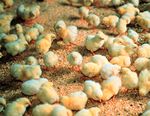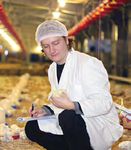Antibiotic Stewardship Within U.S. Poultry Production - 2013-2022 Report
←
→
Page content transcription
If your browser does not render page correctly, please read the page content below
Introduction Relevant Agricultural
Regulations & Information
Updated research, supported by the U.S. Food and Drug Administration and FDA Guidance #209
U.S. Poultry & Egg Association, has been released quantifying the U.S. poultry The judicious use of medically important
industry’s on-farm antibiotic use. The report includes a new section on layer antibiotics in food-producing animals
production. The new report shows further improved antibiotic stewardship calls for 1) limiting medically important
and commitment to disease prevention within poultry production. As part of antibiotics (for human medicine) to uses in
its commitment to the transparency and sustainability of a safe food supply, food-producing animals that are considered
the poultry industry aims to strike a balance between the responsible use necessary for assuring animal health; and 2)
of antibiotics, especially those considered “medically important” to human limiting such antibiotics to uses in food-
health, and keeping poultry flocks healthy. producing animals that include veterinary
oversight or consultation.
Under the research direction of Dr. Randall Singer, DVM, PhD, of Mindwalk
Consulting Group, LLC, this report presents data regarding the use of FDA Guidance #213
antibiotics from 2013 through 2021 for U.S. broiler chickens and turkeys and Provided veterinarians and poultry
from 2016 through 2021 for U.S. layers. A prior report, covering 2013-2017, producers with guidance, information and a
was released in August 2019. deadline by which they would need to align
with Guidance #209.
FDA Veterinary Feed Directive (VFD)
Report Collection Methods VFD Antibiotics are given to the animals
through feed, and permitted only under
the professional supervision of a licensed
veterinarian.
Data regarding antibiotic use among broiler chickens and turkeys was
reported from the hatchery until the day of harvest through the nine-year
collection period of 2013-2021, with major poultry companies in the United
States voluntarily reporting their antibiotic use data. Data for the table egg
industry was reported from the hatchery throughout production for the six-
year collection period of 2016-2021.
For all three datasets, a substantial fraction of U.S. production is included,
based on a comparison to annual U.S. production numbers reported by the
National Agricultural Statistics Service of USDA. Again, participation by these
companies was entirely voluntary. Specifically, the datasets represent:
Approximately Approximately Approximately
150 Million 8 Billion 150 Million
Average Hens in Lay Broiler Chickens Turkeys
What are “Medically Important”
Antibiotics?
45% 85% 70% Medically important antibiotics are those
that are important for treating human
disease, as defined in FDA GFI #152.
(more than 45% of (more than 85% of (more than 70% of
annual U.S. layer/egg annual U.S. chicken annual U.S. turkey
production) production) production)
Antibiotic Stewardship Within U.S. Poultry Production
U.S. Poultry & Egg Association 2013-2022 Report 2Results
Key Changes Among Broiler Chickens
Over the 2013–2021 Period
Broiler chickens receiving antibiotics in the hatchery decreased from 90% (2013) to 0% (2021)
Medically important in-feed antibiotic use in Medically important water-soluble antibiotic use in There was a
broiler chickens decreased substantially: broiler chickens decreased substantially from 2013–2017 documented
and then stabilized or decreased slightly from 2017–2021: shift to the use
There was no
tetracycline virginiamycin tetracycline sulfonamide of antibiotics
92% 98%
reported in-feed lincomycin
100% 97% penicillin
that are not
75% 82
tetracycline use in
2020 or 2021, and
% since 2013
considered
virginiamycin use
since 2013 medically
since peak in 2016
decreased more since peak in 2016 important to
than 95% over the humans (e.g.,
9-year period avilamycin and
bacitracin).
Key Changes Among Turkeys
Over the 2013-2021 Period
Turkeys receiving antibiotics in the hatchery decreased from 97% (2013) to 40% (2021)
Hatchery Medically important Medically important water-soluble antibiotic use in turkeys decreased
gentamicin in-feed antibiotic use substantially from 2013–2017 and then stabilized or increased slightly from
use decreased in turkeys decreased 2017–2021. Increases were typically due to increased disease incidence, as
almost 50% from substantially: seen in other countries as well, during the 2019–2021 period:
2013 to 2021 tetracycline
lincomycin
gentamicin In-feed
80 % penicillin
54 %
neomycin
50%
50 % tetracycline
use decreased
more than
41 %
since peak in 2016
since peak in 2016
since 2013
tetracycline
use remained
80% over the
fairly stable,
9-year period and then
increased in
2020-2021
The Difference Between Broiler Chickens Turkeys
Broiler Chickens and Turkeys • Lower Body Weight • Higher Body Weight
• Shorter Life Span • Longer Life Span
For many reasons, the data records of
• Less Susceptible to • More Susceptible to
antibiotic use among broiler chickens and
Lifetime Illness Lifetime Illness
turkeys in U.S. poultry agriculture should
• Smaller Doses Required • Larger Doses Required
neither be combined nor compared.
Antibiotic Stewardship Within U.S. Poultry Production
U.S. Poultry & Egg Association 2013-2022 Report 3Key Findings Among Layer Chickens Over the 2016-2021 Period
In the U.S. there are three primary phases of commercial egg production:
hatchery, pullet growing farms and egg laying farms. In the U.S., the majority
of chicks purchased by egg companies are sourced from hatcheries that are
Only one medically
owned and operated by genetics companies. Consequently, data regarding important
antimicrobials administered to these day-old pullets prior to arrival on the
pullet farm would be held by the genetics companies. Pullets are then raised antibiotic was used
on farms owned by the production company or contract growers until the in layer production
birds are approximately 16 to 18 weeks
of age. The birds are then transferred for treatment and control of
to egg-laying barns which are often disease: Chlortetracycline (CTC)
located on separate premises from the
pullet farms. Hens will typically begin
laying eggs around 20 weeks of age.
The length of the productive life of a CTC was only administered via the feed in
laying hen depends upon the number pullets and hens
of egg production cycles utilized on the
egg farm but typically ends when the
hen is around 80 to 100 weeks of age.
The majority (>95%) of CTC was used in
the laying hens for treatment of disease
Antibiotic use in layer chickens is very different from broiler chickens
and turkeys. Table egg production is similar to milk production, where Less than 0.2% of total hen-days were
the product for human consumption is produced on a daily basis. Most
exposed to CTC
antibiotics that could be administered to laying hens have withdrawal
periods that would prevent all eggs produced during this period from
entering the food supply. This is one reason why little antibiotic is used in All chicks in the dataset received
table egg production in the U.S. The only medically important antibiotic used gentamicin in the hatchery, which were
in the laying hens in this dataset was chlortetracycline (CTC) administered owned and operated by the genetics
in the feed, in part because it has a zero-day withdrawal, meaning that there
is no loss of eggs during the treatment period. There are no other medically
companies.
important antibiotics that are labeled for use in table egg production hens
that have a zero day withdrawal.
Prevention of Poultry Illness
Poultry producers and veterinarians are most interested in keeping their flocks
healthy and preventing disease, which minimizes the need to use antibiotics. Of
course, sick birds cannot be allowed to suffer, and they cannot be sent to harvest. It
is in everyone’s best interest to keep the birds healthy. Routine activity on this front
includes:
• Hatchery hygiene
• Sanitation of house, feed and water
• Precautions taken to reduce animals’ contact with outside pathogens
• Well-balanced feed formulated by poultry nutritionists
• Vaccinations to prevent common poultry diseases
• Fresh, sanitized drinking water
Antibiotic Stewardship Within U.S. Poultry Production
U.S. Poultry & Egg Association 2013-2022 Report 4Commonly Treated Poultry Illnesses
Several serious bird illnesses continue to present problems to the health and
welfare of U.S. chickens and turkeys. Prevention measures for these diseases
are imperfect, and consequently, antibiotics are used to treat these sick birds.
Several of these key diseases necessitating antibiotic treatment include:
Necrotic enteritis
A clostridial disease, remains one of the most important diseases that
requires antibiotic therapy among broiler chickens
Clostridial dermatitis
Another clostridial disease among broiler chickens, and one of the most
important diseases of turkeys
How Medications Are
Administered
Colibacillosis Veterinarians evaluate flock and
A broad category of E. coli diseases that affect broiler chickens and turkeys
medication circumstances to select the
most effective antibiotic(s). The treatment
Volume Sold vs. Dose Administered options include:
FDA releases annual antibiotic sales reports which provide an estimate
• Injected at the hatchery: Chickens
of the domestic sale and distribution of medically important antibiotics
and turkeys may be injected with
approved for use in food-producing animals. These sales data provide no
vaccine and medication in the egg
details or context for the actual use of these antibiotics on the farm. For this
(in ovo), or as day-old hatchlings, as
reason, FDA is supporting this effort in poultry
needed for preventive health
and other animal ag commodities to understand
how the antibiotics are actually used on the farm.
• Mixed into the feed
To improve overall stewardship of antibiotics in
animal agriculture and to ensure that antibiotics are
• Mixed into the drinking waterfor food
used responsibly, it is critical to work with industry
veterinarians who have oversight of all medically
important antibiotic administrations and who are
collecting data regarding antibiotic use on the farm.
Conclusion
This report points to the continued focus on the judicious use of antibiotics in the U.S. poultry industry, particularly those that are
considered medically important. Moving forward, U.S. Poultry & Egg Association will continue to support Dr. Singer in the annual
collection of data from the layer, broiler and turkey industries . These efforts will continue to assist the poultry industry improve
antibiotic stewardship and will better describe the reasons for on-farm antibiotic usage.
Acknowledgements
This project is funded under a cooperative agreement with the U.S. Food and Drug Administration (U01FD005878) and multiple annual grants from the
U.S. Poultry & Egg Association. The project could not have been such a success without the support and voluntary participation of the FDA, USDA-APHIS,
National Chicken Council, National Turkey Federation, United Egg Producers as well as layer, broiler chicken and turkey companies of the U.S.
Study Reference:
Details of the studies can be found on the website of Mindwalk Consulting Group (https://mindwalkconsultinggroup.com/).
Antibiotic Stewardship Within U.S. Poultry Production
U.S. Poultry & Egg Association 2013-2022 Report 5About the
U.S. Poultry & Egg
Association
The U.S. Poultry & Egg Association (USPOULTRY) is a
non-profit organization which progressively serves its
poultry and egg members through research, education,
communications and technical services. In part, it
is committed to the advancement of research and
education in poultry science and technology, to always
be responsive and effective to the changing needs of the
poultry industry, to increase the availability and constant
improvement of the quality and safety of poultry products
and to promote responsible practices in animal care and
environmental stewardship.
If you have questions about this report,
please use the following contact
resources to inquire further:
U.S. Poultry & Egg Association
1530 Cooledge Road
Tucker, GA 30084-7303
Phone: 770.493.9401
Fax: 770.493.9257
Website: www.uspoultry.org
E-mail: info@uspoultry.orgYou can also read


























































